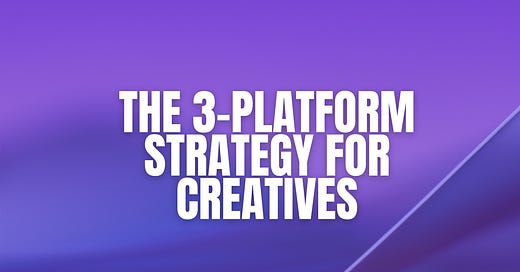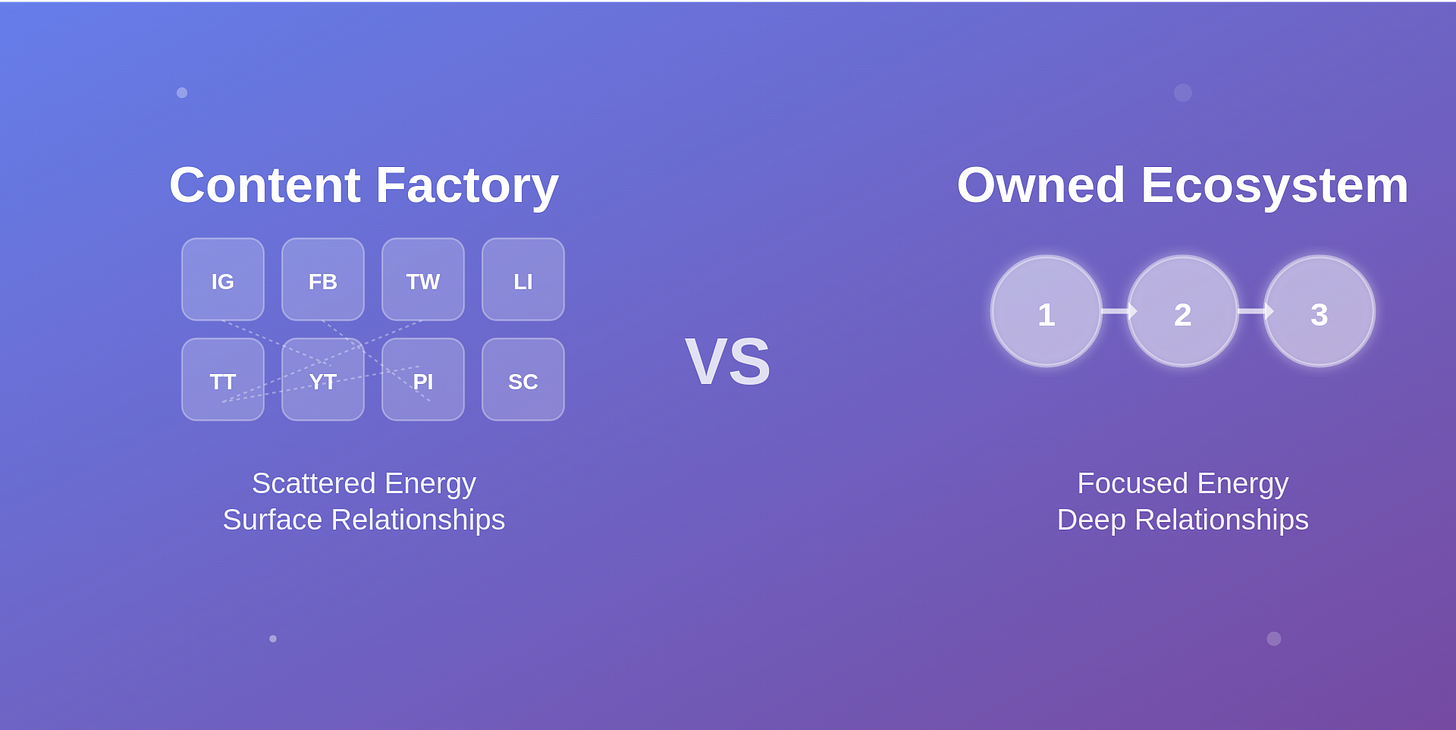The 3-Platform Rule: Why Less is More in Digital Marketing
A deep dive into building meaningful online communities instead of chasing every platform
The digital marketing world has convinced us that success means being everywhere at once. Eight platforms, daily posting, constant engagement, trend-chasing , it’s exhausting. But what if everything we’ve been told about online presence is wrong?
After five months of implementing what I call the “3-Platform Rule,” I’ve discovered something that contradicts nearly every piece of marketing advice you’ve ever heard: less is actually more.
The Content Factory Trap
Most entrepreneurs today aren’t building businesses, they’re building content factories. They wake up each morning not thinking about their customers or their products, but about what to post on Instagram, LinkedIn, TikTok, Facebook, Twitter (X), Pinterest, YouTube, and whatever new platform launched last week.
This approach creates what I call “presence without purpose.” You’re everywhere, but you’re not really anywhere. Your audience sees you, but they don’t know you. You’re generating content, but you’re not creating connection.
The math is simple: if you’re splitting your attention across eight platforms, each one gets 12.5% of your focus. That’s not enough to build the kind of deep, meaningful relationships that actually drive business growth.
What Owned Ecosystems Really Look Like
An owned ecosystem isn’t about owning the platform it’s about owning the relationship. It’s about creating spaces where your community comes to you, not spaces where you’re competing for attention in someone else’s algorithm.
Here’s what most people get wrong about platform selection: they choose based on where their competitors are, not where they can build authentic relationships. They pick platforms because they “should” be there, not because they’re genuinely excited to show up.
When I talk about owned ecosystems, I’m talking about platforms where:
You feel energized after posting, not drained
People engage with your content because it matters to them
Conversations happen naturally, not because you’re forcing them
Your personality and expertise can shine through authentically
The Real Cost of Platform Proliferation
Let’s talk about what it actually costs to maintain eight platforms:
Time: The average entrepreneur spends 3-4 hours daily on social media management. That’s 15-20 hours per week half a full-time job just keeping up with posting schedules.
Mental Energy: Each platform has its own culture, algorithm, and best practices. Context-switching between them is cognitively exhausting and leaves little mental bandwidth for actual business strategy and creativity.
Diluted Messaging: When you’re trying to fit your message into eight different formats for eight different audiences, your core message gets watered down. You become a jack-of-all-trades, master of none.
Surface-Level Relationships: You can’t build deep relationships when you’re spread thin. Your audience gets a diluted version of you, and you never get the chance to become known for anything specific.
The rest of this article reveals the complete 3-Platform Framework, including the exact strategy for choosing your platforms, implementation steps, and what results you can expect. Upgrade to continue reading the full strategy guide.
The 3-Platform Framework: Going Deep Instead of Wide
The 3-Platform Rule isn’t about randomly picking three platforms. It’s about creating a strategic ecosystem where each platform serves a specific purpose in your customer journey.
Platform 1: The Attractor
This is where you attract new people to your world. It might be LinkedIn for B2B professionals, Instagram for visual creators, YouTube for tutorials and knowledge, or TikTok for younger audiences. The key is choosing ONE platform where you can consistently create content that draws your ideal clients in.
Platform 2: The Nurturer
This is where you build deeper relationships. It might be a Facebook group, a Discord server, or even a newsletter (yes, email counts as a platform). This is where people go from knowing about you to actually knowing you.
Platform 3: The Converter
This is where business happens. It might be your website, a sales page, or even a platform where you can have one-on-one conversations. This is where relationships turn into revenue.
The magic happens when these three platforms work together seamlessly. Someone discovers you on Platform 1, engages with you on Platform 2, and does business with you on Platform 3.
Why Depth Beats Breadth Every Time
When you commit to just three platforms, several things happen:
You become known for something specific. Instead of being another voice in the noise, you become the person who always shares valuable insights on LinkedIn, or creates the most engaging conversations in your Facebook group, or hosts the most helpful videos and live sessions on YouTube.
Your content quality improves. With more time and energy to focus on fewer platforms, you can create better content. You can put thought into your posts, engage meaningfully with comments, and build genuine relationships.
Your audience becomes more engaged. When people know where to find you consistently, they start looking for you. They develop habits around your content. They become part of your community, not just your audience.
Your business results improve. Quality relationships drive better business outcomes than quantity metrics. A thousand engaged followers will always outperform ten thousand passive ones.
The FOMO Factor: Addressing the Fear
The biggest objection to the 3-Platform Rule is fear of missing out. “What if my ideal client is on that other platform? What if I’m leaving money on the table?”
Here’s the truth, your ideal client is on every platform. But they’re not actively looking for you on every platform. They’re looking for solutions to their problems, and if you can provide those solutions consistently and authentically on three platforms, they’ll find you.
The fear of missing out is keeping you from showing up fully anywhere. It’s better to be completely present on three platforms than partially present on eight.
Making the Transition: A Practical Guide
If you’re currently on multiple platforms, here’s how to make the transition:
Audit your current platforms. Look at your analytics, but more importantly, look at your energy levels. Where do you feel most engaged? Where do you have the most meaningful conversations? Where does your content perform best?
Choose your three strategically. Pick one platform for attracting new people, one for building deeper relationships, and one for converting relationships into business.
Communicate the change. Let your audience know where they can find you going forward. You don’t need to make a big announcement about leaving platforms, just redirect people to where you’ll be most active.
Go deep gradually. Don’t try to become a power user on all three platforms overnight. Focus on one at a time until you’ve built sustainable systems and genuine engagement.
The Results: What Changes When You Focus
The entrepreneurs who implement the 3-Platform Rule consistently report:
Increased engagement rates across their chosen platforms
Better content quality with more time to focus on fewer pieces
Stronger relationships with their audience and community
Improved business results from quality connections
Reduced stress and better work-life balance
Clearer brand messaging and positioning
Most importantly, they report feeling like they’re building something meaningful instead of just feeding the content machine.
Your Next Steps
The 3-Platform Rule isn’t about limiting yourself, it’s about focusing your energy where it can have the most impact. It’s about building a business that serves you, not one that enslaves you to the endless demands of social media.
Start by asking yourself these questions:
Where am I genuinely excited to show up?
Where do I have the most meaningful conversations?
Where can I build the kind of community I actually want to be part of?
Your business doesn’t need you to be everywhere. It needs you to be somewhere, consistently and authentically. The 3-Platform Rule is how you get there.
The choice is yours, continue building a content factory, or start building an owned ecosystem. The most successful entrepreneurs choose focus over fear, depth over breadth, and relationships over reach.
Your community is waiting for you to show up fully.
Stop making them find you in eight different places and start being the person they can count on in three.







